The Essential Works of Aki Sasamoto
By Camilla Alvarez-Chow
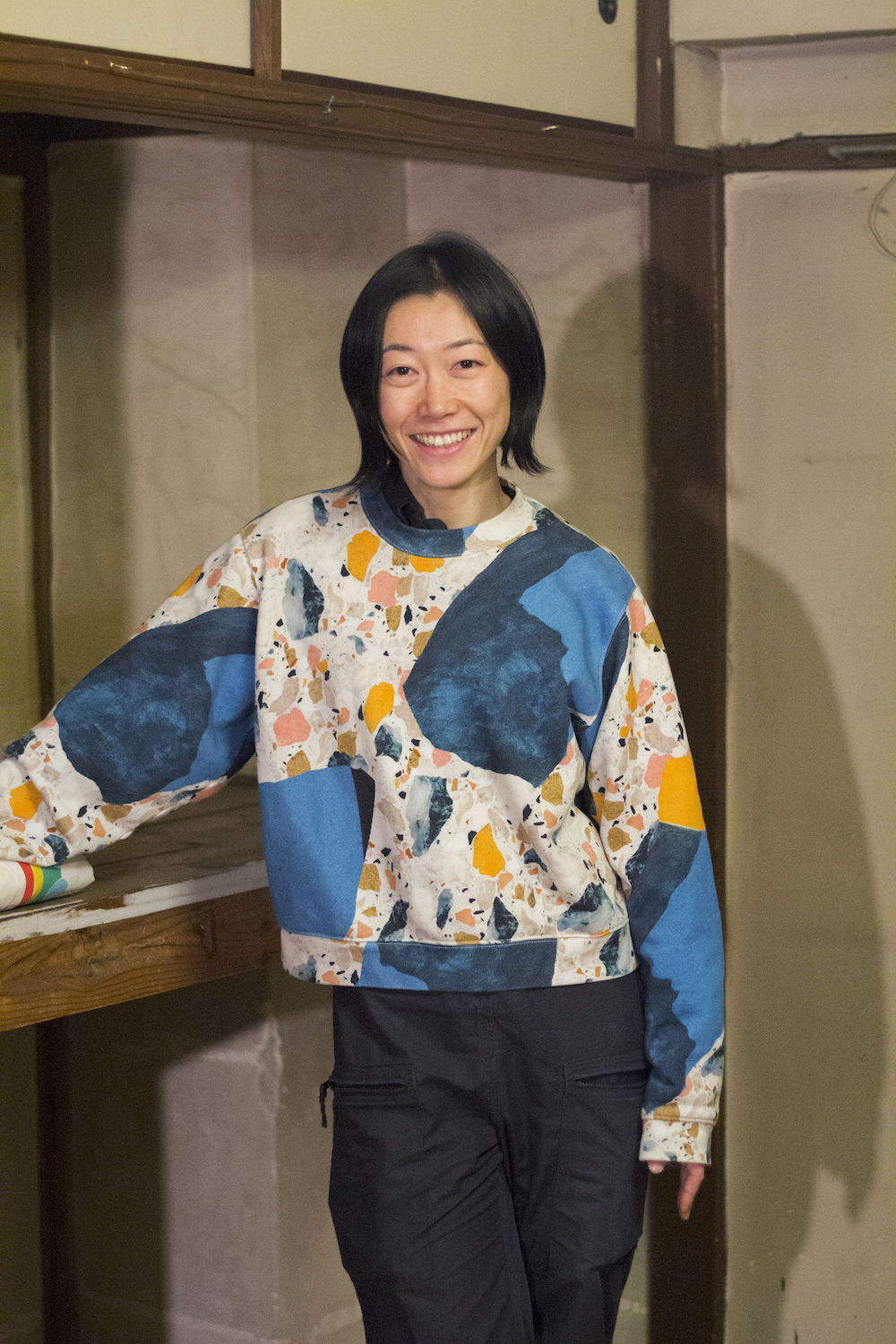
Portrait of AKI SASAMOTO. Photo by Takehiro
Iikawa. Courtesy Take Ninagawa, Tokyo.
For Aki Sasamoto, interest or inspiration can potentially come from anywhere: a passing thought, sound, memory, or an obsession. Known for her installations utilizing found objects, Sasamoto has put herself into many tight spaces, including inside washing machines, down into holes, and behind walls. She has jumped on trampolines, brewed coffee, and drawn many diagrams to reflect on subjects from loneliness, relationships, exhaustion, and even the shape of a doughnut. Listen to Sasamoto long enough and you start to draw parallels to your own existential experiences.
Born in 1980 in Kanagawa, Sasamoto moved to the United States to pursue higher education, at first, in mathematics. When she discovered she could major in the arts, as she once said, “it was all downhill from there.” She earned a BA in dance and studio art from Wesleyan University in Connecticut, and in 2007 completed an MFA at Columbia University School of the Arts in New York. That same year, she started to incorporate dialogue into her performative installations.
Currently based between New York and New Haven where she is a professor at Yale University, Sasamoto has participated in
major international showcases such as the 2008 Yokohama Triennial, “Time
Crevasse,”the 2012 Gwangju
Biennial, “Roundtable”, and the 59th Venice Biennale, “The Milk of Dreams,”in
2022, and at the Mori Art Museum in Tokyo. She continues to showcase her work
extensively in New York such as recent presentations of “Point Reflection” at the
Queens Museum and “Squirrel Ways” at American Academy of Arts and Letters in 2023.
In March, Hong Kong’s nonprofit art space Para Site is hosting Aki Sasamoto’s solo exhibition “Sounding Lines” from March 16 until July 28, 2024. Ahead of this and other upcoming projects in 2024 and 2025, here are five iconic artworks by Aki Sasamoto.
Strange Attractors (2010)
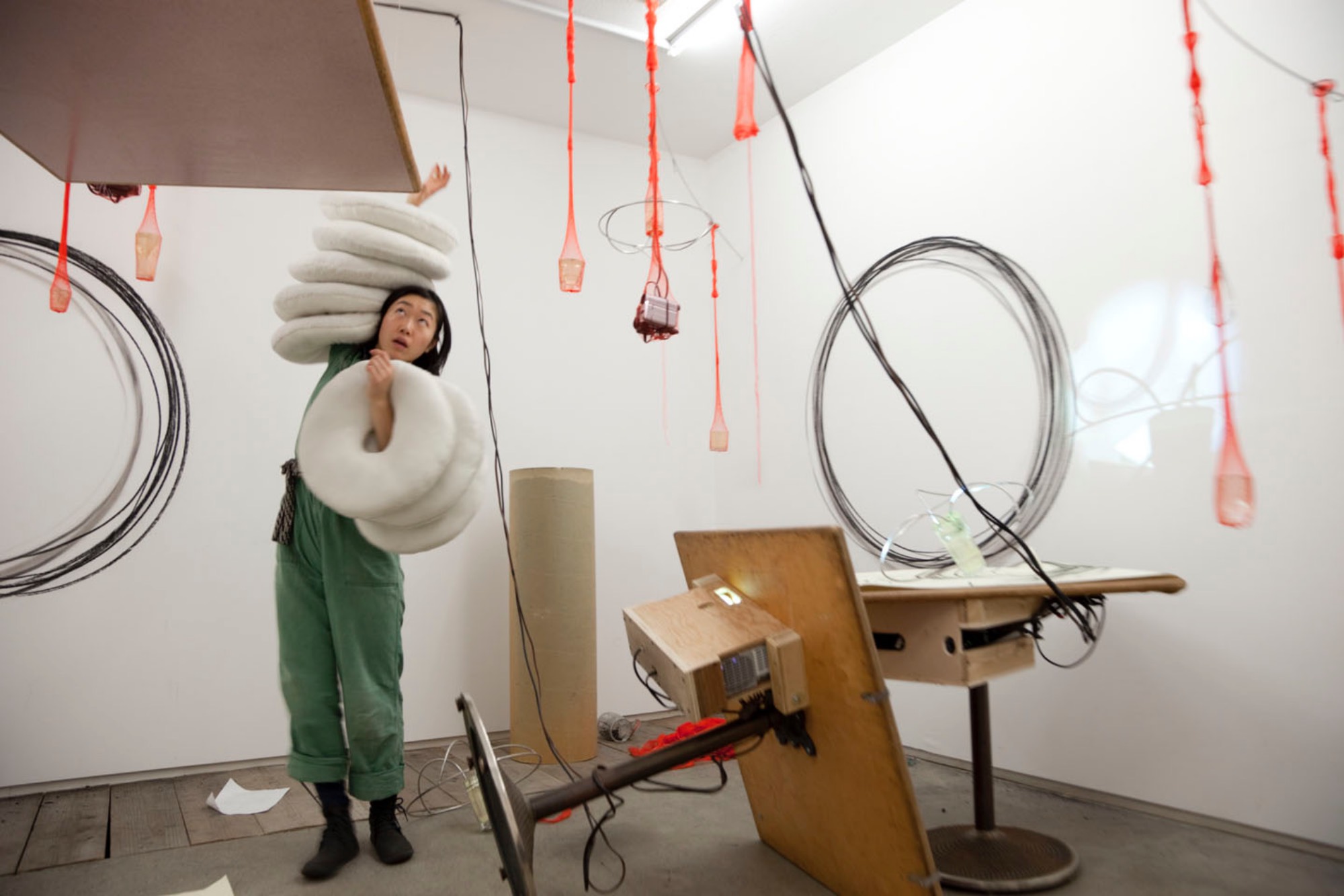

Installation views of AKI SASAMOTO’s Strange Attractors, 2010, performance, household objects, dimensions variable, at Take Ninagawa, Tokyo, 2010. Copyright Aki Sasamoto. Photo by Kei Okano. Courtesy of Take Ninagawa, Tokyo.
Metaphors are indispensable to Sasamoto for communicating the intangible, as they can diverge into many interpretations. In a similar fashion, she transforms objects from their ordinary state in her installation-performances, becoming physical cues for her. Strange Attractors (2010) was first staged at the 2010 Whitney Biennial in New York, with 12 performances on selected dates that included the numbers 6 or 9. The work was staged in a room filled with household objects: tumbler glasses hanging from the ceiling in red plastic nets; there was a wooden table, doughnut-shaped white cushions on the floor, an actual doughnut, large hollow cardboard tubes, and paper sheets on the wall.
Sasamoto started her performance by meandering through the cluttered space, spinning the hanging glasses. Her story was one of fortune tellers, hemorrhoids, and her then recent obsession with doughnuts. Inspired by the mathematical concept of “strange attractors” and the Lorenz curve, Sasamoto riffs on how “tinks” are admired by the “norms,” the “odds” yearn to be “norms,” the “odds” and “tinks” do not dare to interact with each other, and finally that we all aspire to be “Prof. Kaufner,” a scientist who observes everyone from the outside. These existential ponderings ended with Sasamoto inserting herself in a hollow tube, wiggling her way inside and asking the viewer if they have ever been lonely before until, finally, telling them to “go away.” This last statement now makes it clear that these ramblings, on a subconscious level, came from a place of loneliness, of the desire to want to connect and understand others.
Wrong Happy Hour (2014)

Installation view of AKI SASAMOTO’s "Wrong Happy Hour" at JTT, New York, 2014. Copyright Aki Sasamoto. Photo by Charles Benton. Courtesy of Take Ninagawa, Tokyo.
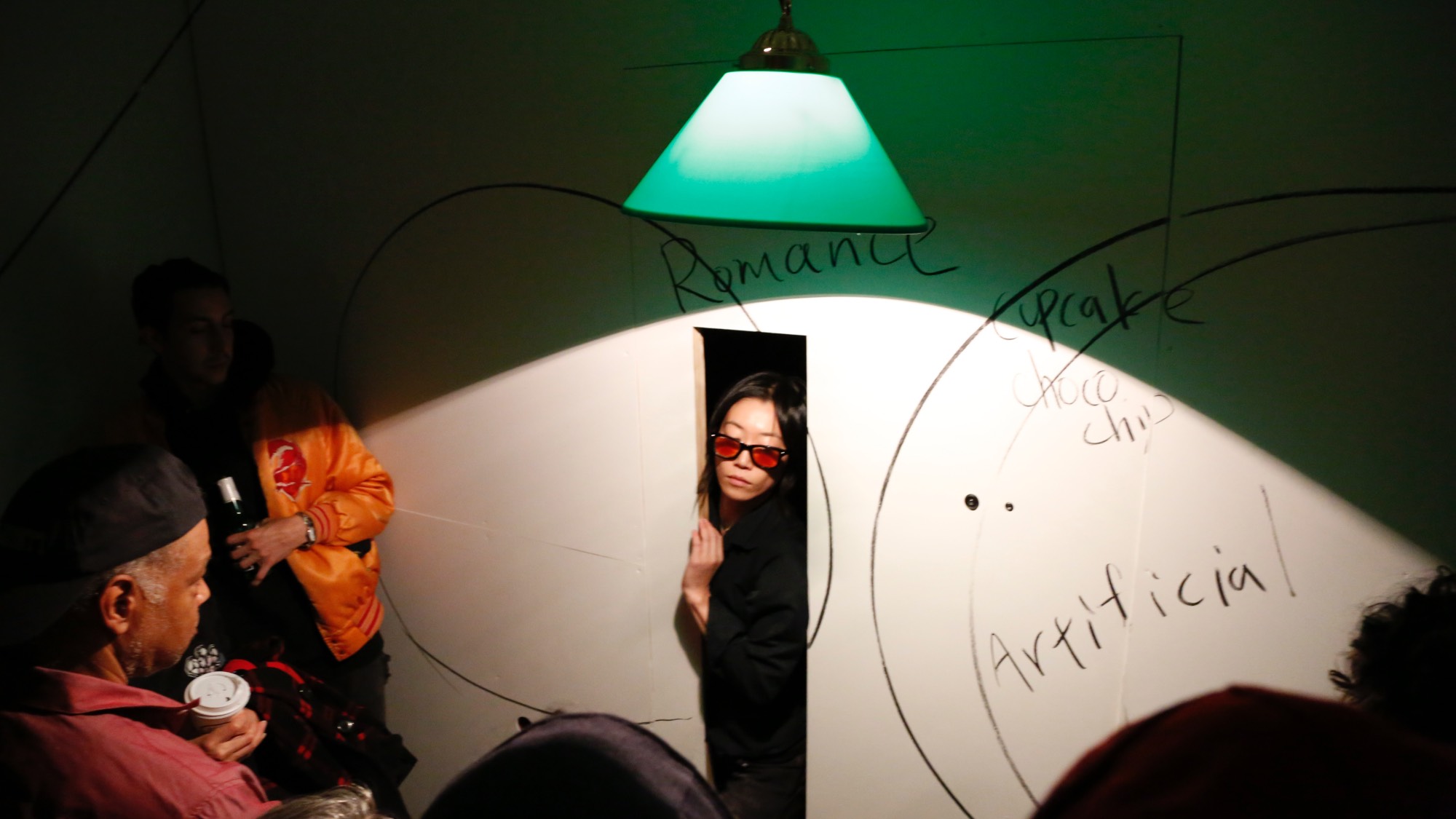
Performance view of AKI SASAMOTO’s, Wrong Happy Hour, 2014, mixed-media installation and performance, dimensions variable, at JTT, New York, 2014. Copyright Aki Sasamoto. Photo by Ben Hagari. Courtesy of Take Ninagawa, Tokyo.
Happy hours—the early evening gathering of discounted drinks and snacks—are favorite occasions for the artist for the atmosphere of camaraderie among strangers who sit in solitude with only a drink as company, lost in deep introspection. Wrong Happy Hour (2014), first performed at JTT gallery in New York, began as any happy hour would, with attendees drinking beer and chatting idly. As Sasamoto went about the venue, she occasionally acted as barkeep and offered beer (and encouraged those who were idle to keep drinking).
The artist proceeded to climb into the metal trash can and move about the room using a broom, pushing against visitors’ shoes. Then she placed the trash can underneath the edge of a table that had rows of empty beer bottles. She began sharing her thoughts on romance and talking through a fan, and injected coffee in her glasses’ lenses, and drew a Venn diagram on the wall. Then, she passed through the back wall via a small cut-out hole and continued to talk about the strange phenomena that is modern romance, occasionally adding to her wall diagram by reaching out through the “door” with only her arm. With Sasamoto’s manipulations, the performance ended as the back wall closed in on audiences, until the space became too cramped. The happy-hour hangers on were left with no choice but to leave as the artist demanded everyone to “get out!” The artist later explained the premise was a metaphor for “tossing out” everyone she was involved with romantically from her life.
Delicate Cycle (2016)
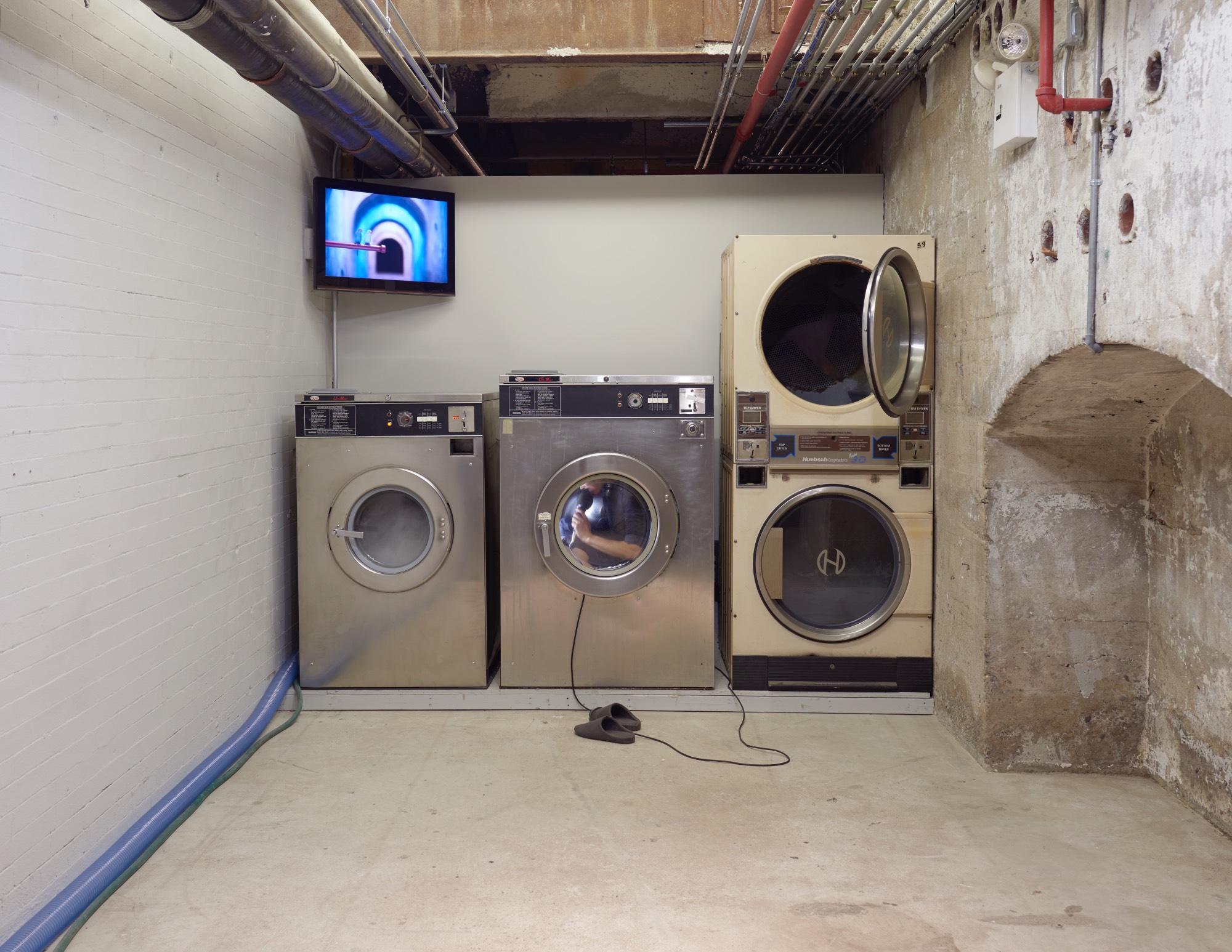
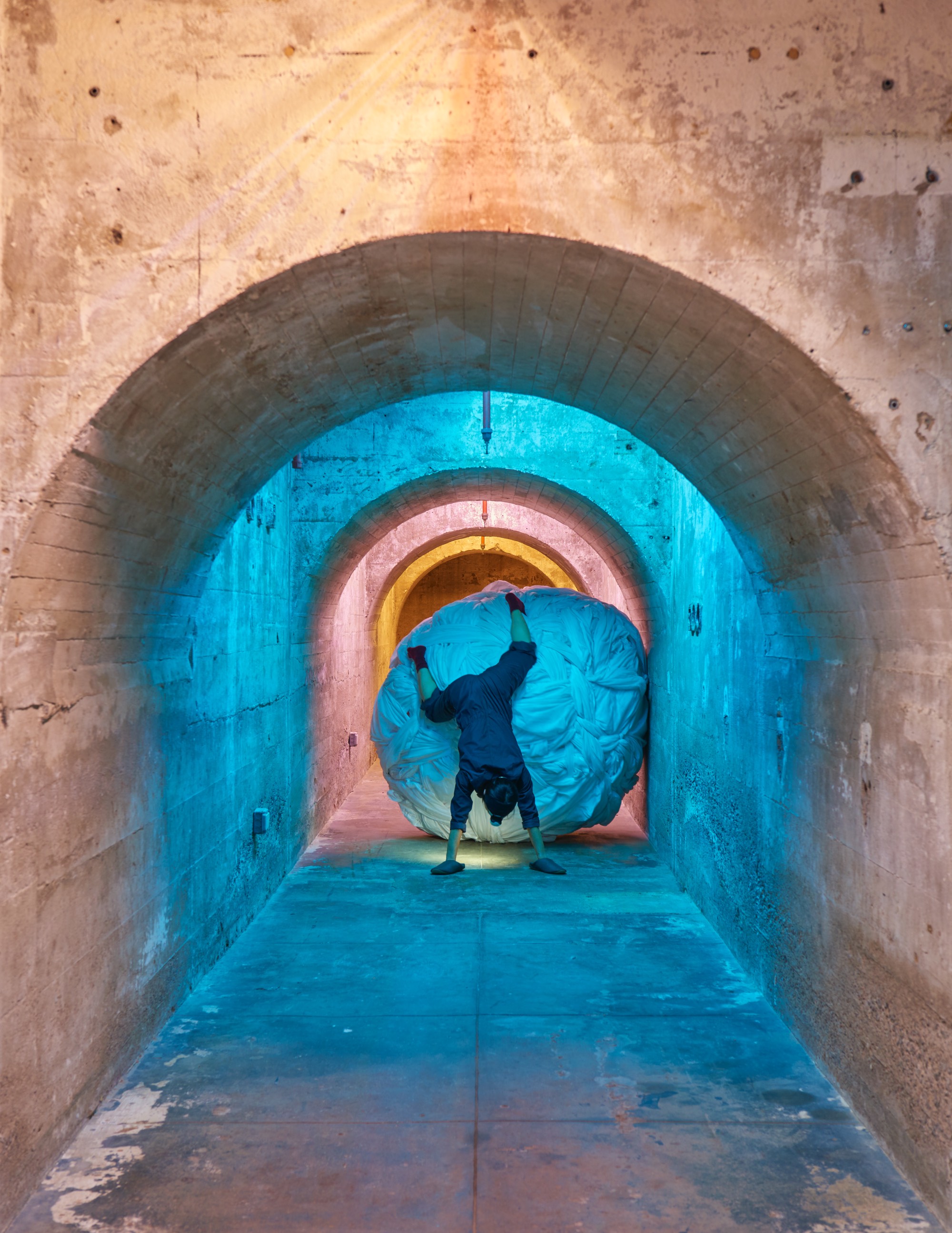
Performance view of "Aki Sasamoto: Delicate Cycle" at Sculpture Center, Queens, New York, 2016. Copyright Aki Sasamoto. Photo by Kyle Knodell. Courtesy of Take Ninagawa, Tokyo.
Commissioned and produced by New York’s SculptureCenter, Delicate Cycle (2016) was a byproduct of Sasamoto life—like all her works. When the artist visited SculptureCenter’s basement, she drew correlations between the underground space and the idea of acts that secretly brought shame. She remembered the joy of sniffing leather shoe polish when she helped shine her father’s shoes as a child and how she used to do the laundry every day at home.
Delicate Cycle starts with Sasamoto strapping a washboard to her back and reaching out with a chained metal ladle and spatula to rattle it. She then stuffed white cloth sheets into a washing machine and turned it on. She began to talk about childhood memories, her obsession with dung beetles, and how everybody was clueless about what the “permanent press” setting meant. Sasamoto then climbed into an empty washing machine and read a segment from her favorite book from childhood, Fabre’s Book of Insects, After this, she continued her performance by imitating a dung beetle, doing a handstand as she pushed a huge ball made out of cloth sheets with her legs down a long hallway.
Entering another room, there were two sculptures that resembled white stalls lacking walls on two opposite sides. Both structures were held up by climbing ropes attached to a pulley system that the artist could use, once inside, to tilt the structure by pulling and releasing the rope. She continued to talk, making more doodles with markers until the washing machine completed its cycle and the artist hung the newly cleaned sheets back onto the clothesline, as if making a fresh start.
Yield Point (2017)
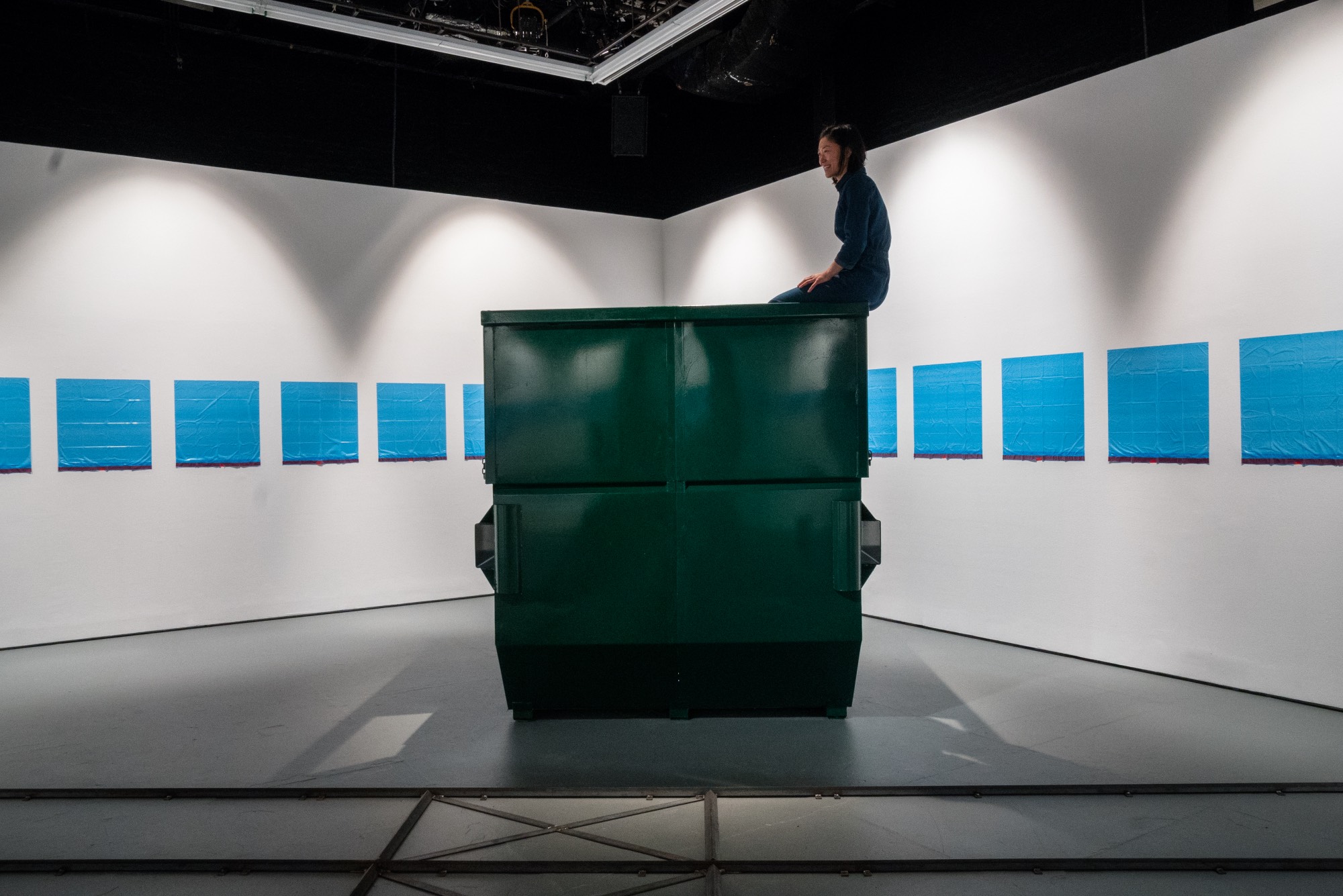
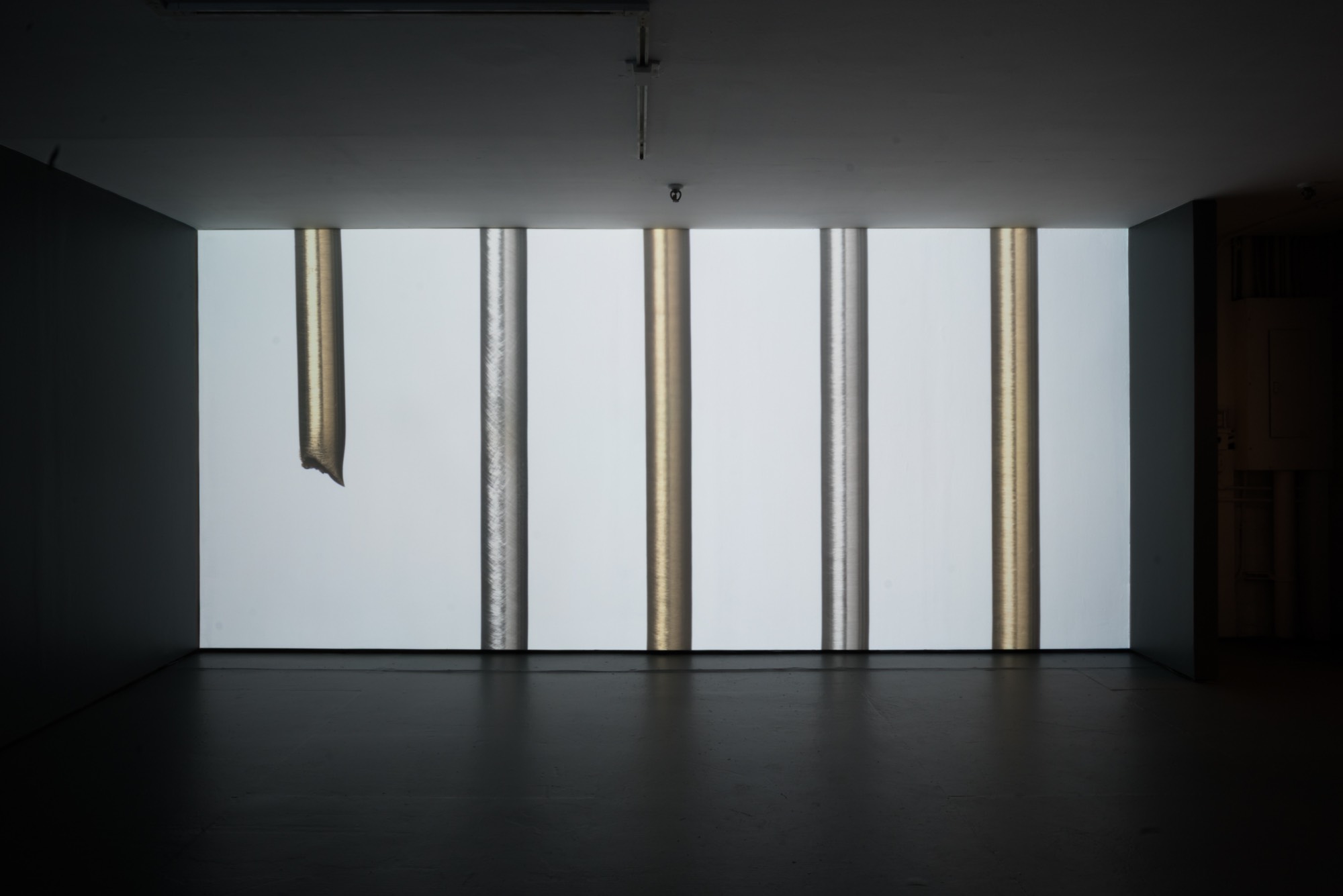
Installation views of AKI SASAMOTO’s "Yield Point" at The Kitchen, New York, 2017. Photos by Jason Mandella. Copyright Aki Sasamoto. Courtesy of The Kitchen, New York, and Take Ninagawa, Tokyo.
Yield Point (2017) is a reference to the eponymous term for when an object begins to become damaged or deformed—at the limit of its elastic capactiy. Sasamoto connects this idea with her feelings of being stretched far too thin in life. Presented for the first time at The Kitchen in New York (at times solo, and other times with American jazz composer Matt Bauder or with Sudanese singer and songwriter Alsarah), the performance starts as the objects in the room begin to transform. She reveals a suspended string of LED lights by pushing two dumpsters apart; the plastic bags in trash cans inflate and deflate, resembling the act of breathing. She drew charts and diagrams to express ideas of resilience: “If you have less elasticity in life, you are easily bored. But if you have more elasticity in life, you may get lost in wandering.” While jumping on a trampoline from within a dumpster, she ends her monologue with questions to the viewer: “Do you want to get bored? Do you want to get lost? How elastic can you be?” Now a parent, Sasamoto has since reflected on her views of challenging one’s own “yield point,” stating that, “Now I don’t push as hard, because I don’t see a point in testing myself like that.”
Sink or Float (2022)
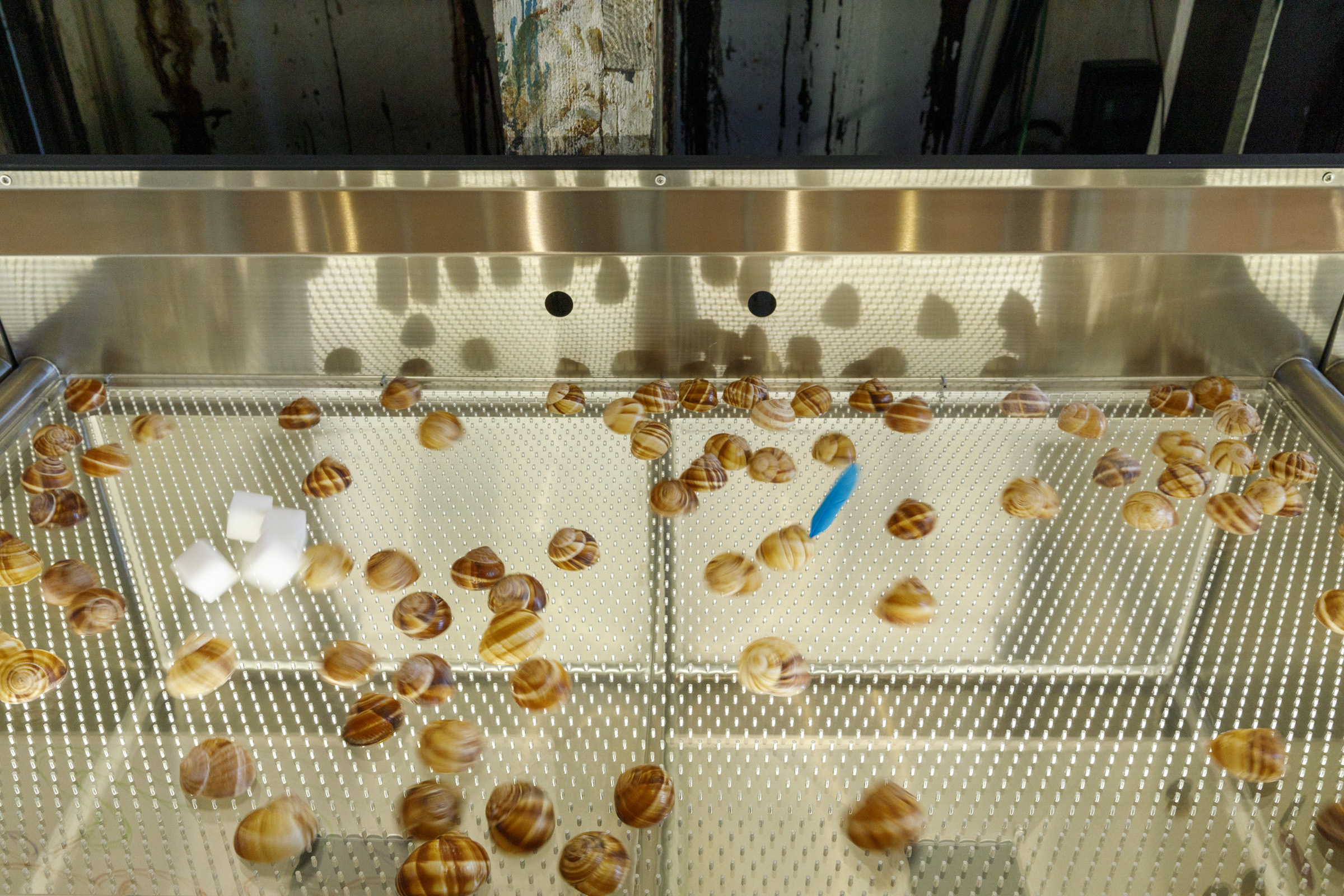
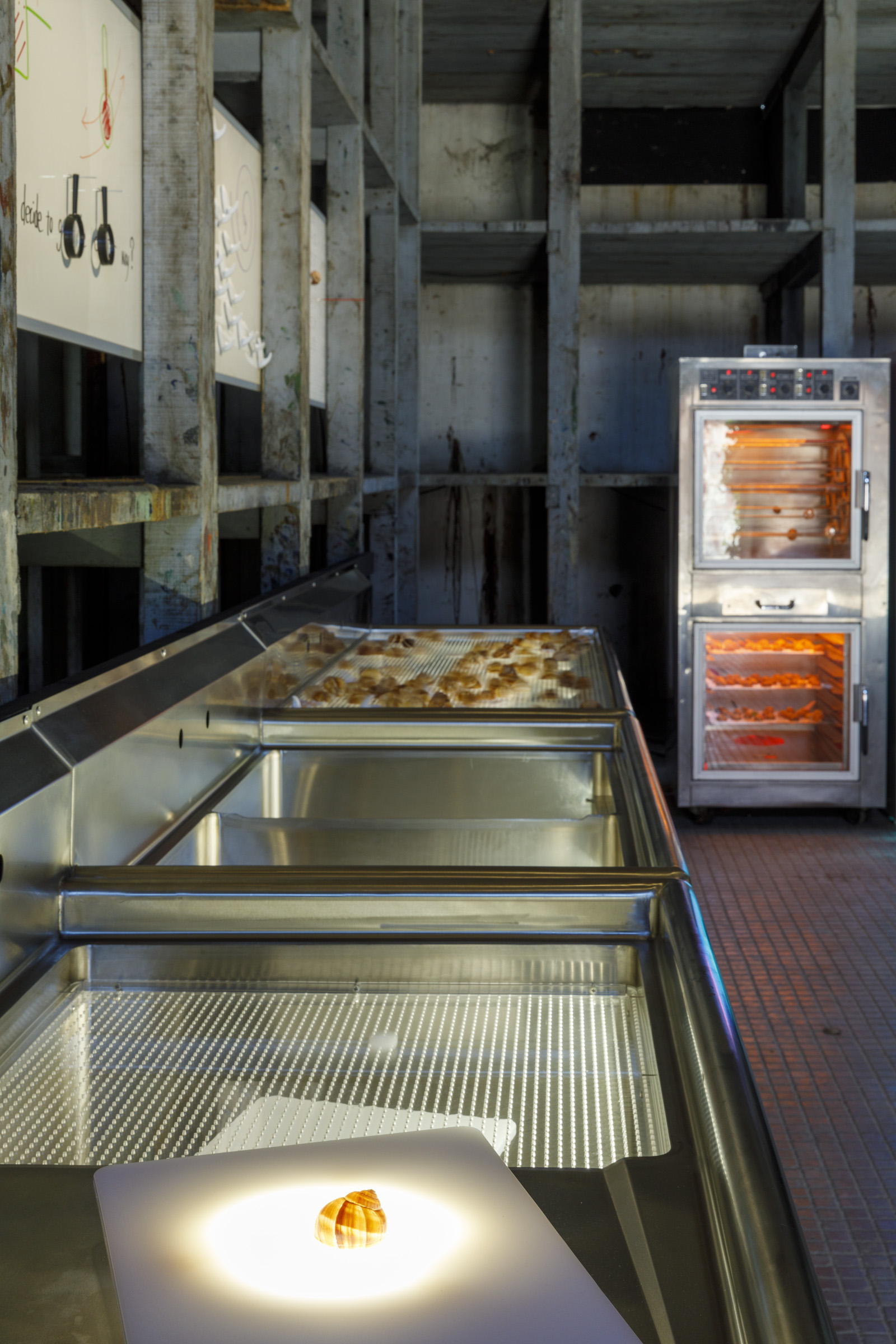
Installation views of AKI SASAMOTO’s Sink or Float, 2022, multimedia installation, dimensions variable, at the 59th Venice Biennale, "The Milk of Dreams," 2022. Photos by Roberto Marossi. Courtesy La Biennale di Venezia.
Commissioned for the 59th Venice Biennale “The Milk of Dreams,” Sink or Float (2022) features performative elements as part of a kinetic sculpture that functioned without the artist’s presence. Sasamoto centers the work around the idea of “the moment when you can’t decide if things are positive or negative, and you have to embrace your predetermined hope and disappointment.” Her son’s collection of snail shells became her new obsession, making the gastropod’s home a prominent “character” in Sink or Float. Sasamoto made the large installation from a series of commercial kitchen sinks topped with a Plexiglas cases that, with air from an HVAC system, mimicked air float tables. She topped the surface with shells, magnifying glasses, melamine sponges, sugar packets, bottle caps, command hooks, and coffee cup lids, which proceeded to glide around and bump into each other constantly, acting out an autonomous dance. Above the sinks were numbers, arrows, thermometers, and spiral shells drawn on whiteboards, along with a notable sentence written: “When do you decide to go the other way?” At the far end of the space she placed refurbished industrial ovens and fridge containing shells placed on top of trays and stacked sponges, respectively.
Sasamoto feels a kindred spirit with everyday objects, imbuing them with metaphor to tell a unique narrative. One cannot pin down an artist such as Sasamoto—who is guided by her own life experiences and intuition. Her artistic fixations arrive by chance and the realization of sculptures yield to the flow of her creative process, with the means justifying the end.
Camilla Alvarez-Chow is an editorial assistant at ArtAsiaPacific.







